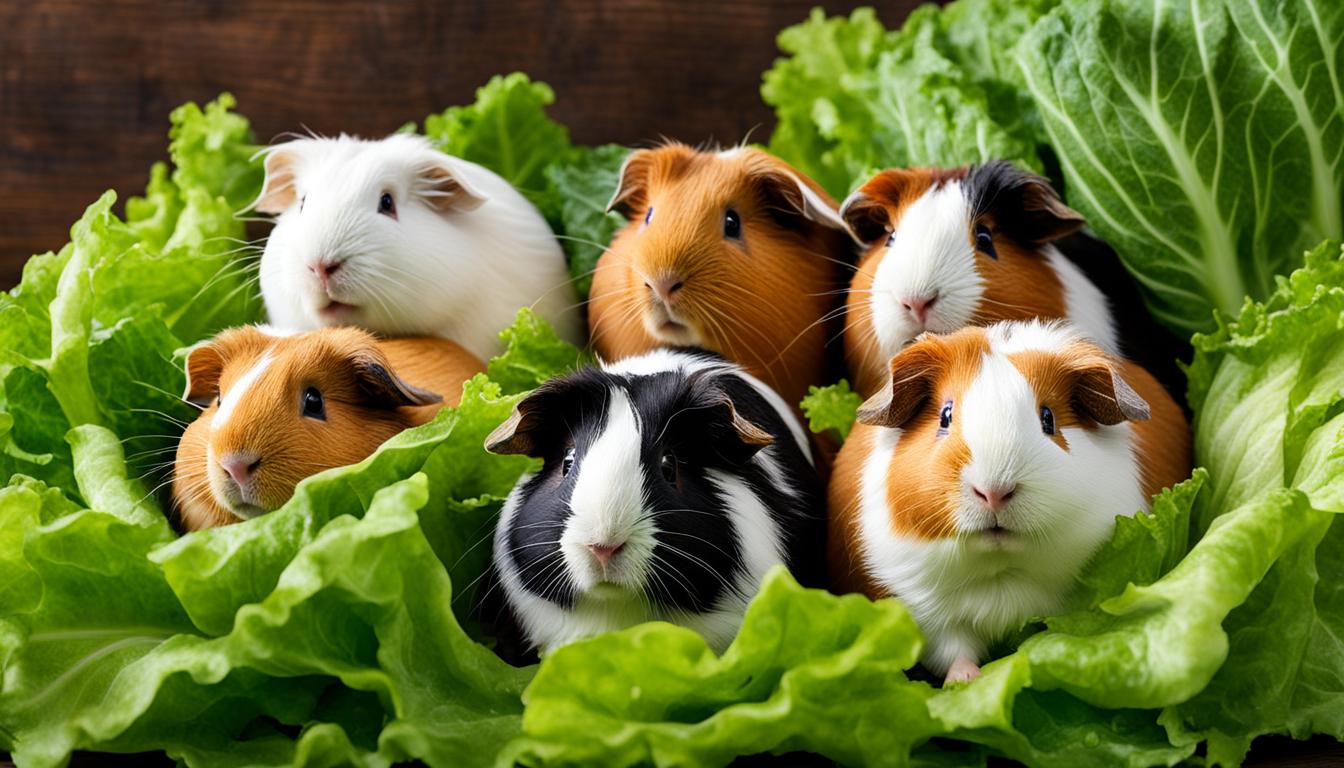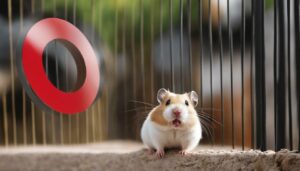Welcome to our article where we explore the intriguing question: can guinea pigs eat romaine lettuce? Many pet owners wonder if this popular vegetable is safe for their furry friends. In this article, we will dive deep into the facts surrounding guinea pigs and romaine lettuce, uncovering the truth about whether it should be included in their diet. Join us as we unravel the mysteries and provide valuable insights into the dietary preferences of these adorable little companions.
Key Takeaways:
- Guinea pigs are herbivores with specific dietary needs that should be met for their overall health and well-being.
- Romaine lettuce can be a nutritious addition to a guinea pig’s diet, as it is high in fiber and a good source of Vitamin C.
- When introducing romaine lettuce, it’s important to do so gradually and in moderation to avoid potential digestive issues.
- Other safe vegetables for guinea pigs include kale, spinach, bell peppers, cucumber, and carrots, providing a variety of vitamins and minerals.
- Observing for any signs of adverse reactions or digestive issues is crucial when introducing new foods to guinea pigs.
Understanding Guinea Pig Dietary Needs
Guinea pigs have specific nutritional needs that are crucial for their overall health and well-being. As herbivores, their diet should consist primarily of plant-based foods. It’s important to provide them with a variety of fresh vegetables to ensure they receive the necessary vitamins and minerals. When it comes to guinea pig care and romaine lettuce, understanding their dietary needs is essential.
One important aspect of a guinea pig’s diet is the inclusion of Vitamin C. Guinea pigs are unable to produce Vitamin C naturally in their bodies, so they rely on dietary sources to meet their requirements. Romaine lettuce is a good source of this essential nutrient. By incorporating romaine lettuce into their diet, you can help support their immune system and overall health.
The Components of a Guinea Pig’s Diet
To fulfill their dietary needs, a guinea pig’s diet should include a variety of vegetables, such as romaine lettuce, as well as high-quality hay and pellets. Hay is an important source of fiber, which promotes healthy digestion in guinea pigs. Pellets should be specially formulated for guinea pigs and should not contain any added sugars or artificial ingredients.
In addition to vegetables, hay, and pellets, guinea pigs also require a constant supply of fresh water. Water is necessary for proper hydration and helps support various bodily functions. Make sure to provide your guinea pig with a clean water source that is easily accessible.
| Nutritional Components of a Guinea Pig’s Diet | Sources |
|---|---|
| Fiber | Hay (Timothy, orchard grass, or meadow grass) |
| Vitamin C | Romaine lettuce, bell peppers, kale, broccoli |
| Protein | Pellets formulated for guinea pigs, limited amounts of fresh vegetables |
| Calcium | Leafy greens in moderation, avoid excessive calcium-rich foods |
Remember to consult with a veterinarian experienced in guinea pig care to ensure you are providing a well-balanced and appropriate diet for your furry friend. They can provide personalized recommendations based on your guinea pig’s specific needs and health condition.
The Benefits of Romaine Lettuce for Guinea Pigs
When it comes to the health of our beloved guinea pigs, providing them with a nutritious diet is essential. Romaine lettuce is one vegetable that can offer numerous benefits to these small furry friends. Rich in vitamins and fiber, romaine lettuce can contribute to their overall well-being and support their specific dietary needs.
Romaine lettuce is an excellent source of Vitamin C, which is crucial for guinea pigs as they are unable to produce it naturally in their bodies. Vitamin C plays a vital role in their immune system, helping to fight off diseases and keep them healthy. By including romaine lettuce in their diet, we can ensure they receive an adequate amount of this essential vitamin.
In addition to Vitamin C, romaine lettuce is also high in fiber. This fiber content promotes healthy digestion in guinea pigs, preventing issues such as constipation and diarrhea. A healthy digestive system is essential for their overall well-being and can help prevent digestive problems in the long run.
The Benefits of Romaine Lettuce for Guinea Pigs (continued)
| Benefits of Romaine Lettuce | How it Supports Guinea Pig Health |
|---|---|
| Rich in Vitamin C | Boosts the immune system, prevents diseases |
| High in fiber | Promotes healthy digestion, prevents constipation |
When feeding romaine lettuce to your guinea pig, it’s important to do so in moderation. While it offers many health benefits, it should not be the sole component of their diet. Romaine lettuce can be included as a supplement alongside other guinea pig-friendly vegetables and their primary diet of hay, pellets, and water.
By incorporating romaine lettuce into your guinea pig’s diet, you can provide them with essential nutrients, support their immune system, and ensure they have a healthy digestive system. Remember to introduce it gradually and monitor their response. With the proper care and a well-balanced diet, your guinea pig can thrive and live a happy, healthy life.
Incorporating Romaine Lettuce into a Guinea Pig’s Diet
If you’re considering feeding romaine lettuce to your guinea pig, it’s important to do so in a safe and controlled manner. Romaine lettuce can be a healthy addition to their diet, but it should not replace the main components of their nutrition, which include hay, pellets, and water. Here are some guidelines for incorporating romaine lettuce into your guinea pig’s diet:
Gradual Introduction
Start by offering a small piece of romaine lettuce to your guinea pig and observe their response over the next 24 hours. If they show no adverse reactions such as diarrhea or digestive upset, you can gradually increase the amount of romaine lettuce over the course of several days. This slow and controlled introduction allows their digestive system to adapt to the new food.
Moderation is Key
While romaine lettuce is nutritious, it should still be offered in moderation. Too much romaine lettuce can lead to weight gain and digestive issues in guinea pigs. As a general rule, romaine lettuce should make up no more than 10% of your guinea pig’s overall diet. Remember to balance their diet with a variety of other vegetables to ensure they receive a well-rounded nutrition.
Wash and Prepare Properly
Before offering romaine lettuce to your guinea pig, make sure to wash it thoroughly to remove any dirt or pesticides. Cut the romaine lettuce into small, bite-sized pieces that are easy for your guinea pig to consume. Remove any wilted or damaged leaves as they may not be as fresh or safe for consumption.
| Veggies | Frequency |
|---|---|
| Romaine Lettuce | 2-3 times per week |
| Kale | 2-3 times per week |
| Bell Peppers | 1-2 times per week |
Remember that every guinea pig is unique, and their dietary needs may vary. It’s important to monitor their health and consult with a veterinarian if you have any concerns or questions about their diet. By following these guidelines and incorporating romaine lettuce in moderation, you can offer your guinea pig a varied and nutritious diet.
Other Safe Vegetables for Guinea Pigs
In addition to romaine lettuce, there are several other vegetables that are safe and nutritious for guinea pigs. These vegetables provide a variety of vitamins and minerals that can support their overall health and well-being. Here are some examples of safe vegetables that you can include in your guinea pig’s diet:
- Kale: Rich in Vitamin C and other essential nutrients, kale is a great choice for guinea pigs. It is best to serve it in small amounts to avoid digestive issues.
- Spinach: Another leafy green vegetable that guinea pigs can enjoy is spinach. Like kale, it is packed with nutrients, but it should also be fed in moderation due to its high oxalate content.
- Bell Peppers: Colorful and crunchy, bell peppers are a tasty treat for guinea pigs. They are a good source of Vitamin C and provide a refreshing texture to their diet.
- Cucumber: Adding slices of cucumber to your guinea pig’s diet can provide hydration and a cool crunch. Just make sure to remove the seeds before serving.
- Carrots: Carrots are not only rich in Vitamin A but also provide a satisfying crunch for guinea pigs. They should be given in moderation due to their high sugar content.
These vegetables can be served raw, washed thoroughly, and cut into suitable sizes for your guinea pig to enjoy. Remember to introduce new vegetables gradually and observe their response to ensure they tolerate them well. By providing a variety of safe vegetables, you can enrich your guinea pig’s diet and contribute to their overall health.
| Vegetable | Nutritional Benefits |
|---|---|
| Kale | High in Vitamin C and other essential nutrients |
| Spinach | Rich in nutrients, but should be fed in moderation due to oxalate content |
| Bell Peppers | Good source of Vitamin C and adds crunch to the diet |
| Cucumber | Provides hydration and a cool crunch |
| Carrots | Rich in Vitamin A, but should be given in moderation due to sugar content |
Risks and Considerations
When it comes to including romaine lettuce in a guinea pig’s diet, there are certain risks and considerations that need to be taken into account. While romaine lettuce can be a nutritious addition, it should not be the sole focus of their diet. Moderation is key to avoid potential issues.
One of the main risks associated with feeding too much romaine lettuce to guinea pigs is weight gain. Lettuce, including romaine lettuce, has a high water content and can contribute to excess calorie intake. This can lead to obesity, which can have detrimental effects on a guinea pig’s health.
Another consideration is the calcium balance in a guinea pig’s diet. While romaine lettuce is low in calcium compared to other greens, feeding excessive amounts can still disrupt the delicate calcium-phosphorus balance in their bodies. This can lead to bladder and kidney issues, such as bladder stones.
Lastly, too much romaine lettuce can also cause digestive problems in guinea pigs. The high water and fiber content can result in loose stools or diarrhea. It’s important to observe your guinea pig’s response to romaine lettuce and adjust the amount accordingly to avoid any digestive issues.
| Risks and Considerations: | |
|---|---|
| Weight gain | Obesity and related health problems |
| Calcium balance | Disruption of calcium-phosphorus balance and bladder stones |
| Digestive problems | Loose stools or diarrhea |
Nutritional Benefits of Zucchini for Guinea Pigs
Zucchini is a versatile vegetable that can provide several nutritional benefits for guinea pigs. It is packed with essential vitamins and minerals that contribute to their overall health and well-being. Including zucchini in their diet can offer a tasty and nutritious addition to their mealtime.
One of the key benefits of zucchini is its high water content, which helps to keep guinea pigs hydrated. Additionally, zucchini is low in calories, making it a healthy option for those looking to manage their guinea pig’s weight. It is also rich in fiber, which supports proper digestion and helps prevent constipation.
Zucchini Nutritional Profile
Here is a breakdown of the key nutrients found in zucchini:
| Key Nutrients | Benefits |
|---|---|
| Vitamin C | Boosts immune system and promotes overall health |
| Vitamin A | Supports eye health and strengthens the immune system |
| Potassium | Helps maintain proper heart function and supports muscle health |
| Magnesium | Contributes to bone health and helps regulate blood sugar levels |
It’s important to note that zucchini should be fed to guinea pigs in moderation, as with any new food. Start by offering a small piece and observe their response for 24 hours. If there are no adverse reactions, you can gradually increase the amount over several days. Remember to always provide a well-rounded diet that includes a variety of vegetables to meet their nutritional needs.
Incorporating Zucchini into a Guinea Pig’s Diet
When it comes to feeding zucchini to guinea pigs, it’s important to do so in a safe and responsible manner. Zucchini can be a nutritious addition to their diet, providing essential vitamins, minerals, and fiber. To ensure that your guinea pig benefits from this vegetable, follow these guidelines:
Introduction and Observation
Introduce zucchini gradually into your guinea pig’s diet. Start by offering a small piece and observe their response for 24 hours. Look for any signs of allergic reactions or digestive issues, such as skin irritation, sneezing, diarrhea, or loss of appetite. If there are no adverse reactions, you can gradually increase the amount of zucchini over several days.
Moderation and Variety
While zucchini can be a healthy addition to their diet, it should be given in moderation. Too much zucchini can lead to digestive problems and weight gain. Remember to maintain their primary diet of hay, pellets, and water while incorporating zucchini as a supplement. Variety is key in a guinea pig’s diet, so be sure to offer other vegetables along with zucchini to ensure they receive a balanced nutrition.
Preparation and Serving
| Preparation and Serving Tips for Zucchini |
|---|
| Rinse the zucchini thoroughly to remove any dirt or residue. |
| Remove the ends and any tough skin on the zucchini. |
| Cut the zucchini into small, bite-sized pieces that are easy for your guinea pig to eat. |
| Offer the zucchini to your guinea pig on a clean plate or dish. |
| Remove any uneaten zucchini from their enclosure after a few hours to prevent spoilage. |
| Remember to always provide fresh water alongside their meal. |
By following these guidelines, you can safely incorporate zucchini into your guinea pig’s diet and provide them with the necessary nutrients for their overall well-being. Remember to consult with a veterinarian if you have any specific concerns or questions about your guinea pig’s diet.
Signs of Allergic Reactions or Digestive Issues
When feeding zucchini to your guinea pig, it’s important to be attentive to any signs of allergic reactions or digestive issues. While zucchini is generally safe for guinea pigs, some individuals may have specific sensitivities or intolerances. Here are some signs to watch out for:
Allergic Reactions:
- Skin irritation: Look for redness, rashes, or excessive scratching.
- Sneezing: Frequent or prolonged sneezing can indicate an allergic reaction.
Digestive Issues:
- Diarrhea: Loose or watery stools may indicate digestive upset.
- Loss of appetite: If your guinea pig suddenly refuses to eat or shows disinterest in food, it may be a sign of digestive discomfort.
- Bloating: A distended abdomen or signs of discomfort can indicate gas or digestive issues.
If you notice any of these symptoms after feeding zucchini to your guinea pig, it’s important to remove the food immediately. Monitor their behavior and consult a veterinarian if necessary. They will be able to provide further guidance and ensure your guinea pig’s health and well-being.
| Symptoms | Possible Causes |
|---|---|
| Skin irritation | Allergic reaction |
| Sneezing | Allergic reaction |
| Diarrhea | Digestive upset |
| Loss of appetite | Digestive discomfort |
| Bloating | Gas or digestive issues |
Tips for Buying and Preparing Zucchini
When incorporating zucchini into your guinea pig’s diet, it’s crucial to choose fresh and high-quality zucchinis. Look for zucchinis that are firm and vibrant green, with no blemishes or soft spots. Selecting the best zucchinis will provide your guinea pig with the highest nutritional value.
Before serving zucchini to your furry friend, it’s essential to thoroughly rinse the vegetable to remove any wax or coating that may be present. This will help ensure that your guinea pig is consuming clean and safe zucchini.
When preparing the zucchini for your guinea pig, remove the ends and cut it into small, bite-sized pieces that are easy for them to chew. Remember to introduce zucchini gradually and in moderation to their diet, observing their response to avoid any adverse reactions or digestive issues.
| Zucchini Buying and Preparation Tips for Guinea Pigs |
|---|
| Choose fresh and vibrant green zucchinis without blemishes or soft spots |
| Thoroughly rinse the zucchini to remove wax or coating |
| Remove the ends and cut it into small, bite-sized pieces |
| Introduce zucchini gradually and in moderation to their diet |
By following these tips, you can ensure that your guinea pig receives the best quality zucchini and enjoys it as a delicious and nutritious part of their diet. Remember to always prioritize your guinea pig’s health and well-being by providing a varied and balanced diet that meets their nutritional needs.
Conclusion
After careful examination of the facts, we can conclude that romaine lettuce can be a safe and nutritious addition to a guinea pig’s diet. It provides essential vitamins and minerals, particularly Vitamin C, which is crucial for their overall health. However, it’s important to introduce romaine lettuce gradually and in moderation to avoid any potential health issues, such as weight gain or digestive problems. Alongside romaine lettuce, it’s crucial to provide a well-rounded diet that includes a variety of vegetables to meet their nutritional needs.
Remember, guinea pigs require a primarily plant-based diet and hay, pellets, and water should remain the foundation of their nutrition. Romaine lettuce, along with other safe vegetables like kale, spinach, bell peppers, cucumber, and carrots, can be offered as supplements to provide variety and additional nutrients. The key is to observe your guinea pig’s response and adjust accordingly.
Always ensure that the romaine lettuce you feed your guinea pig is fresh and of high quality. Thoroughly rinse the leaves and remove any wax or coating before serving it to your furry friend. By following these guidelines and providing a balanced diet, you can support your guinea pig’s overall health and well-being.
Additional Tips for Guinea Pig Care
When it comes to caring for your guinea pig, there are a few additional tips that can help ensure their well-being and happiness. First and foremost, it’s important to provide a clean living environment for your furry friend. Clean the cage regularly, removing any waste and replacing bedding as needed. This will help prevent the buildup of bacteria and keep your guinea pig healthy.
Exercise is also crucial for guinea pigs, as it helps promote physical and mental stimulation. Create a safe and spacious area for your guinea pig to explore outside of their cage. You can use pet playpens or create a secure space in your home where they can roam freely. Just be sure to supervise them at all times to prevent any accidents.
Another important aspect of guinea pig care is social interaction. Guinea pigs are social animals and thrive in the company of others. If possible, consider getting a companion for your guinea pig to keep them entertained and engaged. However, introduce new guinea pigs slowly and carefully to ensure they get along.
Lastly, regular veterinary check-ups are essential for maintaining your guinea pig’s health. Schedule routine visits to the vet to ensure your guinea pig is up to date on vaccinations and to address any health concerns. Your vet can also provide guidance on proper nutrition and care specific to your guinea pig’s needs.
FAQ
Can guinea pigs eat romaine lettuce?
Yes, guinea pigs can eat romaine lettuce. It is a nutritious vegetable that provides essential vitamins and minerals for their overall health.
How much romaine lettuce should I feed my guinea pig?
Romaine lettuce should be introduced gradually and in moderation. Start with a small piece and observe their response. If there are no adverse reactions, you can gradually increase the amount over several days.
What are the benefits of romaine lettuce for guinea pigs?
Romaine lettuce is a good source of Vitamin C, which is essential for their immune system. It is also high in fiber, promoting healthy digestion in guinea pigs.
Can guinea pigs eat other vegetables besides romaine lettuce?
Yes, guinea pigs can eat a variety of vegetables. Some safe options include kale, spinach, bell peppers, cucumber, and carrots.
What are the risks of feeding romaine lettuce to guinea pigs?
Feeding too much romaine lettuce can lead to weight gain, calcium imbalance, and digestive issues. It’s important to practice moderation and observe your guinea pig’s response.
Can guinea pigs eat zucchini?
Yes, zucchini can be fed to guinea pigs. It is a nutritious vegetable that provides essential vitamins, minerals, and fiber.
How should I introduce zucchini to my guinea pig?
Start with a small piece of zucchini and observe their response. If there are no adverse reactions, you can gradually increase the amount over several days.
What are the signs of allergic reactions or digestive issues in guinea pigs?
Look out for symptoms such as skin irritation, sneezing, scratching, diarrhea, loss of appetite, or bloating. If any adverse reactions occur, remove the food immediately and consult a veterinarian if needed.
How do I choose and prepare zucchini for my guinea pig?
Select fresh and high-quality zucchinis that are firm and vibrant green without blemishes or soft spots. Thoroughly rinse the zucchini and remove any wax or coating before serving it to your guinea pig.
What other factors should I consider when caring for guinea pigs?
Along with a balanced diet, it’s important to provide a clean and spacious living environment, regular exercise, and social interaction for your guinea pig’s well-being and happiness.




